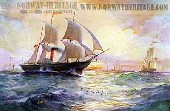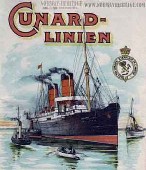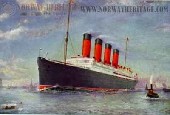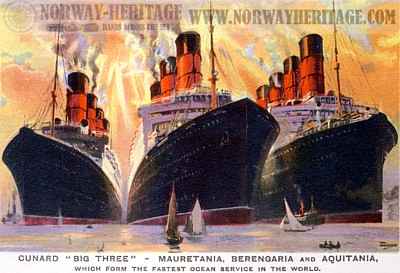|
|
 S/S Britannia  Cunard Line advertisement  S/S Mauretania |
(The British and North American Royal Mail Steam Packet Company)
One of the first shipping men to realize the practical advantages of steam packets over sailing vessels was Samuel Cunard, a leading merchant and ship owner of Halifax. For several years Samuel Cunard had been operating a fleet of ships carrying on the mail service between Boston, Newfoundland and Bermuda. For a long time he had entertained the thought of developing a line of steamers to cross the ocean.
At that time the mails between England and America, carried by more or less obsolete government sailing vessels, were irregular and uncertain. Mr. Cunard formulated a plan in 1830 to substitute a regular steamship mail service between the continents, but capital was not obtainable and the project was delayed.
In 1838, the British government, convinced of the feasibility of steamship service by the voyage between Bristol and New York of the paddle steamer Great Western, invited bids for a speedier and more regular steam carrier system for ocean mails. Here was Samuel Cunard's opportunity to develop his dream under the auspices of the British government. Merchants of Halifax did not look with approval on his scheme, so Mr. Cunard sailed for England to raise the necessary capital. Letters of introduction led to a meeting with Mr. George Burns of Glasgow, and Mr. David MacIver of Liverpool, two of the ablest shipping men in England, both engaged in the coasting trade between England, Ireland and Scotland.
These three maritime pioneers soon perfected their plans, raised the required funds, and Mr. Cunard submitted his tender to the Commissioner of the Admiralty. His offer was better than one made by the owners of the Great Western, and was accepted. It called for the conveyance of the mails once a fortnight between Liverpool, Halifax and Boston. The original intention to maintain this service with three steamships was altered to provide four steamships, fixed sailing dates, and certain other provisions calculated to insure regularity. The line started operations in 1840 and was first known as the British and North American Royal Mail Steam Packet Company. The pioneer vessels of the Cunard fleet have passed into the history of the British Mercantile Marine. They were the Britannia, Acadia, Caledonia and Columbia.
The Britannia of 1840 was 1,154 tons gross. The Scotia, 3,871 tons, the finest paddle steamer that ever crossed the ocean, was built in 1862. The Scotia remained the largest vessel of the fleet until 1874 when she was eclipsed by the Bothnia, of 4,556 tons, which was followed in 1875 by her sister ship, the first Scythia. The largest Cunarder in commission in 1880 was the Gallia, of 4,808 tons, four times the tonnage of the Britannia.
In 1850 Collins Line came into being. The outstanding feature of their scheme was to provide larger and faster vessels and so drive the Cunard flag from the Atlantic, or at least put it in second place. The challenge to a speed contest by the Collins Line was ignored. Instead, the Cunard Line went on with a steady building program, and looked well to the safety and comfort of their passengers, with the result that, though beaten in the time of their voyages, the Line steadily gained recognition as the steamship company which offered travelers the maximum of comfort and the minimum of risk.
The Cunard Line was one of the first British transatlantic companies to establish a network of passenger agents to deal with the conveyance of emigrants from the Scandinavian countries. The general agent in Norway was located in Christiania (now Oslo). In towns like Stavanger, Bergen and Trondheim there were head agents, controlling a network of sub agents which operated in the surrounding areas. The Cunard Line never had direct sailings between the Scandinavian countries and North American ports. Their transatlantic ships departed from Liverpool to Boston and New York (and Canada). Scandinavian emigrants traveling with the Cunard Line thus had to travel via Britain. For many years the most common route was by the Wilson Line steamers to Hull and from Hull by train to Liverpool. In Liverpool they would some times have to stay for a couple of days. There were several hotels and boarding houses that was operated by the different transatlantic companies in Liverpool.
The Cunard Line entered upon the second stage of its career in 1880, when a prospectus was issued stating that "the growing wants of the Company‘s transatlantic trade demanded the acquisition of additional steamships of great size and power, involving a cost for construction which might best be met by a large public company. Two years previous the Company had been registered under the Limited Liability Acts. The name of the company was then changed to The Cunard Steam Ship Company Limited.
In the eighties, with the addition to the fleet of the Servia, Aurania, Umbria and Etruria, the sure foundations of steady advancement were laid. The nineties saw it further increased by the Campania and Lucania, record breakers of 13,000 tons and twenty-two knots speed. Other notable vessels built for the Line were the Ivernia, Saxonia and Carpathia, the Caronia and Carmania, "the pretty sisters," launched in 1905.
Then in 1906 came the first of the giant express steamers, the Lusitania and her sister Mauretania. At the time of their launching they enjoyed the dual distinction of being the largest and fastest vessels which naval architects had produced. How they justified the expectations of their owners and builders, and how Europe and America awaited with interest the notification of each day's run, is now a matter of history. They were succeeded, however, by a still larger vessel, the Aqiuitania, all ships which has become legends in the history of the transatlantic passenger trade.
Diagram showing comparative size of various types of Cunard mail steamers from 1840 to 1893. Ships: Britannia, Acadia, Columbia and Caledonia 1840, Hibernia and Cambria 1843, America, Niagara, Europa and Canada 1848, Asia and Africa 1850, Arabia 1852, Persia 1855, Scotia 1862, China 1862, Java 1865, Russia 1867, Bothnia and Scythia 1874, Gallia 1879, Servia 1881, Aurania 1882, Umbria and Etruria 1884, Campania and Lucania 1893. For each ship information about length, breadth, dept moulded, gross tonnage, indicated horse power, average speed in knots per hour and year built is given.
Support Norway Heritage: Purchase a copy
 The Big Three, Cunard Line steamships Mauretania, Berengaria and Aquitania Support Norway Heritage: Purchase a copy
Cunard Line - advertisement poster - 3rd class - advertising service to Canada and the United States. To Canada - Quebec and Montreal in summer, Halifax in Winter. Ships. Andania, Antonia, Ascania, Athenia, Ausonia, Aurania, Alaunia and Letitia, all of 14,000 tons, built 1922-25. To the U.S.A. - New York and Boston. Ships: Aquitania 47,00 tons, Berengaria 52,000 tons, Mauretania 31,000 tons, the fastest ships i the World. Carinthia, Franconia, Laconia, Samaria and Scythia, all of 20,000 tons built 1922-25. Interior pictures from a 3rd class 2-berth cabin, 3rd class ladies saloon, 3rd class 4-berth cabin, 3rd class dining saloon, 3rd class smoking saloon and a 3rd class bath room. Text in Norwegian, issued by general agent Olaf H. Solem, Trondhjem.
Support Norway Heritage: Purchase a copy
| Type | Name of ship  | Year Built  | Construction Shipyard  | Tonnage (burthen)  |
|---|
| S/S | Abyssinia | 1870 | J. & G. Thomson & Co. | 3,376 gross | | S/S | Acadia | 1840 | John Wood & Co. | 1,154 gross | | S/S | Africa | 1850 | Robert Steele & Co. | 2,226 gross | | S/S | Alaunia (1) | 1913 | Scott‘s Shipbuilding & Eng. Co. Ltd | 13,405 gross | | S/S | Alaunia (2) | 1925 | John Brown & Co. Ltd. | 14,040 gross | | S/S | Albania (1) | 1900 | C. S. Swan & Hunter | 7,640 gross | | S/S | Albania (2) | 1920 | Scott‘s Shipbuilding & Eng. Co. Ltd | 12,767 gross | | S/S | Aleppo | 1864 | J. & G. Thomson & Co. | 2,057 gross | | S/S | Algeria | 1870 | J. & G. Thomson & Co. | 3,428 gross | | S/S | Alps | 1852 | William Denny & Co. | 1,440 gross | | S/S | America | 1848 | Robert Steele & Co. | 1,826 gross | | S/S | Andania (1) | 1913 | Scott‘s Shipbuilding & Eng. Co. Ltd | 13,405 gross | | S/S | Andania (2) | 1921 | Hawthorn, Leslie & Co. Ltd. | 13,950 gross | | S/S | Andes | 1852 | William Denny & Co. | 1,440 gross | | S/S | Antonia | 1921 | Vickers Ltd. | 13,867 gross | | | Aquitania | 1913 | John Brown & Co. Ltd. | 45,647 gross | | S/S | Arabia (2) | 1852 | Robert Steele & Co. | 2,402 gross | | S/S | Ascania (1) | 1911 | Swan, Hunter & Wigham Richardson | 9,111 gross | | S/S | Ascania (2) | 1925 | Armstrong Whitworth & Co. | 14,013 gross | | S/S | Asia (1) | 1850 | Robert Steele & Co. | 2,226 gross | | S/S | Athenia | 1922 | Fairfield Shipbuilding & Eng. Co. Ltd. | 13,465 gross | | S/S | Atlas | 1860 | J. & G. Thomson & Co. | 1,794 gross | | S/S | Aurania (1) | 1882 | J. & G. Thomson & Co. | 7,269 gross | | S/S | Aurania (2) | 1916 | Swan, Hunter & Wigham Richardson | 13,936 gross | | S/S | Aurania (3) | 1924 | Swan, Hunter & Wigham Richardson | 13,984 gross | | S/S | Ausonia (1) | 1909 | Swan, Hunter & Wigham Richardson | 7,907 gross | | S/S | Ausonia (2) | 1921 | Armstrong Whitworth & Co. | 13,912 gross | | S/S | Australasian | 1857 | J. & G. Thomson & Co. | 2,902 gross | | S/S | Balbec | 1852 | William Denny & Co. | 774 gross | | S/S | Batavia | 1870 | William Denny & Co. | 2,553 gross | | S/S | Berengaria | 1913 | AG Vulcan | 52,226 gross | | S/S | Bothnia (1) | 1874 | J. & G. Thomson & Co. | 4,535 gross | | S/S | Brest | 1874 | Blackwood & Gordon | 1,463 gross | | S/S | Britannia | 1840 | Robert Duncan & Co. | 1,156 gross | | S/S | British Queen | 1849 | William Denny & Co. | 773 gross | | S/S | Calabria | 1857 | J. & G. Thomson & Co. | 2,902 gross | | S/S | Caledonia | 1840 | Wood | 1,154 gross | | S/S | Cambria | 1844 | Robert Steele & Co. | 1,422 gross | | S/S | Cameronia (1) | 1911 | D. & W. Henderson Ltd. | 10,963 gross | | S/S | Cameronia (2) | 1919 | William Beardmore & Co. | 16,365 gross | | S/S | Campania | 1892 | Fairfield Shipbuilding & Eng. Co. Ltd. | 12,950 gross | | S/S | Canada | 1848 | Robert Steele & Co. | 1,831 gross | | S/S | Carinthia (1) | 1895 | London & Glasgow Co. Ltd. | 5,598 gross | | S/S | Carinthia (2) | 1925 | Vickers Ltd. | 20,277 gross | | S/S | Carmania | 1905 | John Brown & Co. Ltd. | 19,524 gross | | S/S | Caronia | 1904 | John Brown & Co. Ltd. | 19,687 gross | | S/S | Carpathia | 1902 | C. S. Swan & Hunter | 13,555 gross | | S/S | Cassandra | 1906 | Scott‘s Shipbuilding & Eng. Co. Ltd | 8,135 gross | | S/S | Catalonia | 1881 | J. & G. Thomson & Co. | 4,841 gross | | S/S | Cephalonia | 1882 | Laird Bros | 5,517 gross | | S/S | China | 1861 | Robert Napier & Sons | 2,638 gross | | S/S | Columbia | 1841 | Robert Steele & Co. | 1,154 gross | | S/S | Corsica | 1863 | J. & G. Thomson & Co. | 1,134 gross | | S/S | Cuba | 1864 | Tod & McGregor | 2,668 gross | | S/S | Damascus | 1856 | William Denny & Co. | 1,214 gross | | S/S | Demarara | 1872 | J. & G. Thomson & Co. | 1,904 gross | | S/S | Emeu | 1853 | Robert Napier & Sons | 1,538 gross | | S/S | Emperor of India | 1914 | Caird & Co. | 11,430 gross | | S/S | Etna | 1855 | Caird & Co. | 2,215 gross | | S/S | Etruria | 1884 | John Elder & Co. | 7,718 gross | | S/S | Europa | 1847 | John Wood & Co. | 1,834 gross | | S/S | Franconia (1) | 1910 | Swan, Hunter & Wigham Richardson | 18,150 gross | | S/S | Franconia (2) | 1922 | John Brown & Co. Ltd. | 20,175 gross | | S/S | Gallia | 1878 | J. & G. Thomson & Co. | 4,809 gross | | S/S | Hecla | 1860 | Robert Napier & Sons | 1,785 gross | | S/S | Hibernia | 1843 | Robert Steele & Co. | 1,422 gross | | S/S | Imperator | 1912 | AG Vulcan | 52,226 gross | | S/S | Ivernia | 1899 | C. S. Swan & Hunter | 14,058 gross | | S/S | Java | 1865 | J. & G. Thomson & Co. | 2,696 gross | | S/S | Jura | 1854 | J. & G. Thomson & Co. | 2,241 gross | | S/S | Kaiserin Auguste Victoria | 1905 | AG Vulcan | 24,581 gross | | S/S | Kedar | 1860 | William Denny & Co. | 1,783 gross | | S/S | Laconia (1) | 1911 | Swan, Hunter & Wigham Richardson | 18,099 gross | | S/S | Laconia (2) | 1921 | Swan, Hunter & Wigham Richardson | 19,680 gross | | S/S | Lancastria | 1920 | William Beardmore & Co. | 16,243 gross | | S/S | Lebanon | 1854 | J. & G. Thomson & Co. | 1,373 gross | | S/S | Lettia | 1924 | Fairfield Shipbuilding & Eng. Co. Ltd. | 13,475 gross | | S/S | Lucania | 1893 | Fairfield Shipbuilding & Eng. Co. Ltd. | 12,952 gross | | S/S | Lusitania | 1906 | John Brown & Co. Ltd. | 31,550 gross | | S/S | Malta | 1865 | J. & G. Thomson & Co. | 2,132 gross | | S/S | Marathon | 1860 | Robert Napier & Sons | 1,784 gross | | S/S | Margaret | 1839 | Caird & Co. | 700 gross | | S/S | Marocco | 1861 | William Denny & Co. | 1,855 gross | | S/S | Mauretania (1) | 1906 | Swan, Hunter & Wigham Richardson | 31,938 gross | | S/S | Melita | 1853 | Alexander Denny | 1,254 gross | | S/S | Nantes | 1874 | Blackwood & Gordon | 1,473 gross | | S/S | Nemisis | 1857 | Tod & McGregor | 2,717 gross | | S/S | Niagara | 1847 | Robert Steele & Co. | 1,824 gross | | S/S | Olympus | 1860 | J. & G. Thomson & Co. | 1,794 gross | | S/S | Orduna | 1913 | Harland & Wolff | 15,499 gross | | S/S | Oregon | 1883 | John Elder & Co. | 7,347 gross | | S/S | Palestine | 1858 | Robert Steele & Co. | 1,800 gross | | S/S | Palmyra | 1865 | Caird & Co. | 2,044 gross | | S/S | Pannonia | 1903 | John Brown & Co. Ltd. | 9,851 gross | | S/S | Parthia | 1870 | William Denny & Co. | 3,167 gross | | S/S | Pavonia | 1882 | J. & G. Thomson & Co. | 5,588 gross | | S/S | Persia | 1855 | Robert Napier & Sons | 3,300 gross | | S/S | Royal George | 1907 | Fairfield Shipbuilding & Eng. Co. Ltd. | 11,146 gross | | S/S | Russia | 1867 | J. & G. Thomson & Co. | 2,960 gross | | S/S | Samaria | 1868 | J. & G. Thomson & Co. | 2,574 gross | | S/S | Samaria (2) | 1921 | Vickers Ltd. | 19,602 gross | | S/S | Saragossa | 1874 | J. & G. Thomson & Co. | 2,263 gross | | S/S | Saturnia | 1910 | Charles Connell & Co. | 8,611 gross | | S/S | Saxonia | 1899 | John Brown & Co. Ltd. | 14,281 gross | | S/S | Scotia (1) | 1861 | Robert Napier & Sons | 3,871 gross | | S/S | Scythia (1) | 1874 | J. & G. Thomson & Co. | 4,557 gross | | S/S | Scythia (2) | 1920 | Vickers Ltd. | 19,730 gross | | S/S | Servia | 1881 | J. & G. Thomson & Co. | 7,392 gross | | S/S | Siberia | 1867 | J. & G. Thomson & Co. | 2,498 gross | | S/S | Sidon | 1861 | William Denny & Co. | 1,872 gross | | S/S | Slavonia | 1902 | James Laing & Co. | 10,606 gross | | S/S | Sylvania (1) | 1895 | London & Glasgow Co. Ltd. | 5,598 gross | | S/S | Tarifa | 1865 | J. & G. Thomson & Co. | 2,058 gross | | S/S | Taurus | 1853 | William Denny & Co. | 1,126 gross | | S/S | Transylvania | 1914 | Scott‘s Shipbuilding & Eng. Co. Ltd | 14,315 gross | | S/S | Trinidad | 1872 | J. & G. Thomson & Co. | 1,900 gross | | S/S | Tripoli | 1863 | J. & G. Thomson & Co. | 2,057 gross | | S/S | Tuscania (1) | 1914 | Alexander Stephen & Sons | 14,348 gross | | S/S | Tuscania (2) | 1921 | Fairfield Shipbuilding & Eng. Co. Ltd. | 16,991 gross | | S/S | Tyrrhenia | 1920 | William Beardmore & Co. | 16,243 gross | | S/S | Ultonia | 1898 | C. S. Swan & Hunter | 8,845 gross | | S/S | Umbria | 1884 | John Elder & Co. | 7,718 gross | | S/S | Vandyck | 1921 | Workman, Clark & Co. Ltd. | 13,233 gross | | S/S | Vasari | 1908 | Raylton Dixon & Co. | 10,117 gross | | S/S | Vauban | 1912 | Workman, Clark & Co. Ltd. | 10,660 gross | | S/S | Vestris | 1912 | Workman, Clark & Co. Ltd. | 10,494 gross |
|
Note:
You can click the  icon to sort the table by different parameters.
Some companies may have had additional ships in their fleets to those mentioned above. They might not have been included if the ships were not engaged in the conveyance of emigrants. Some ships mentioned in the fleet lists may have been chartered from other companies, see the ship's description and history for more details. |
|
|
|